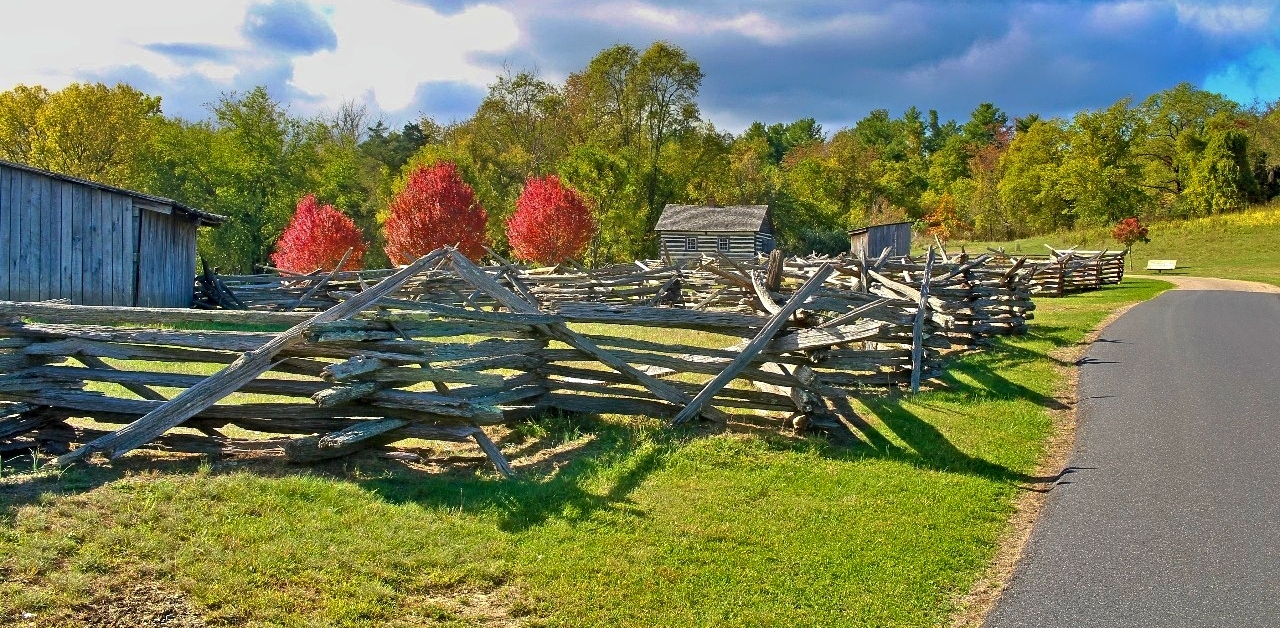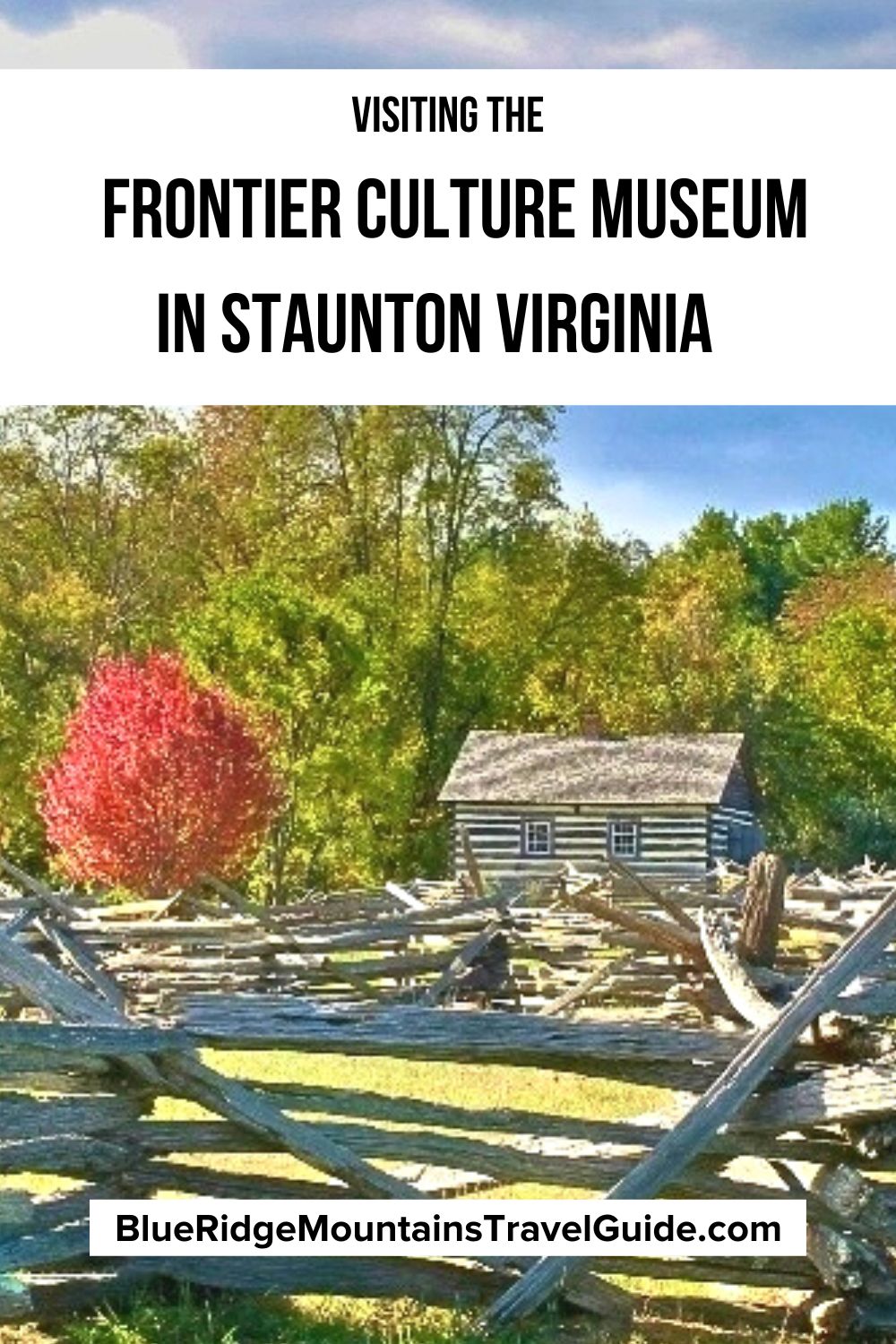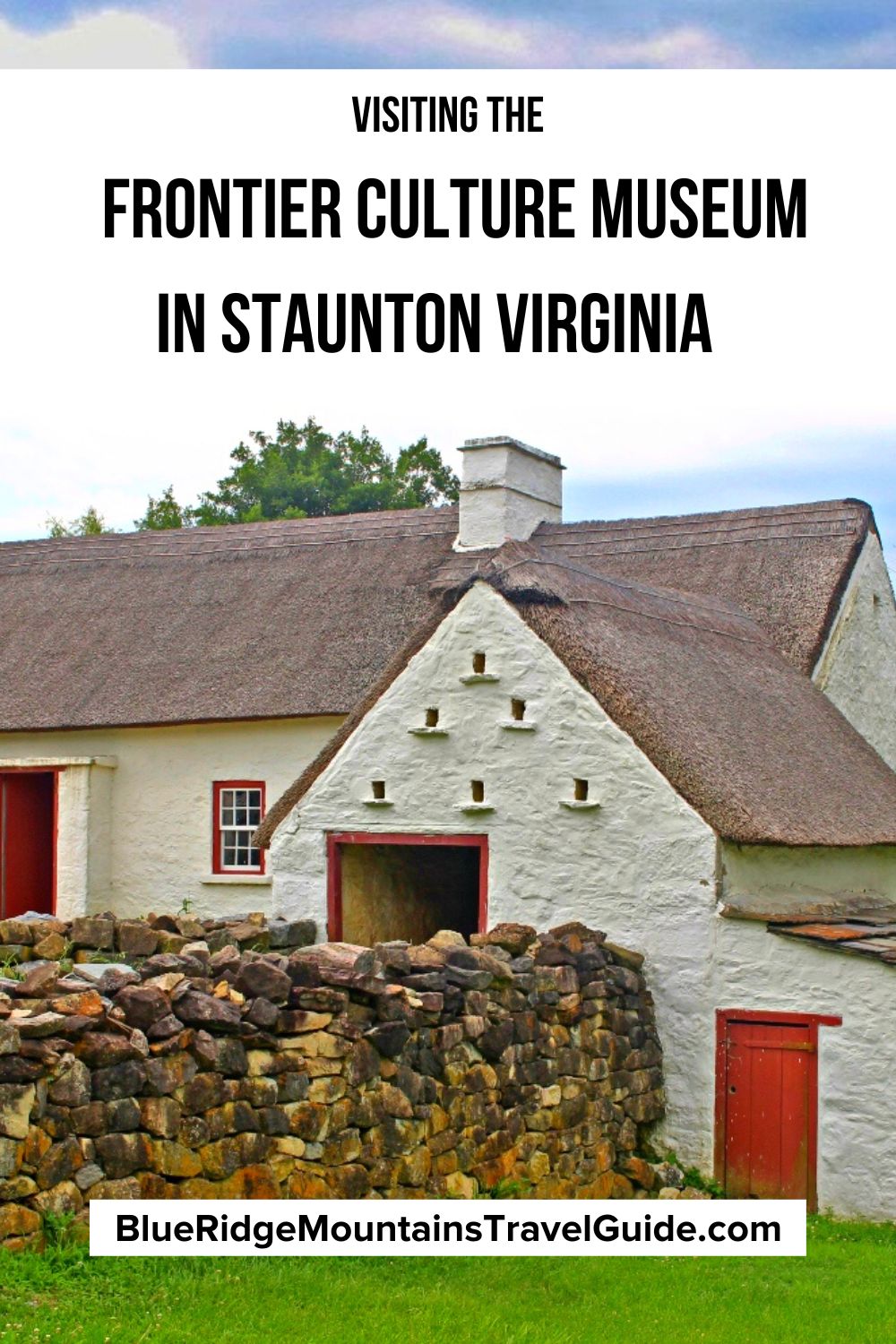Located 3 miles from Downtown Staunton VA, the Frontier Culture Museum is the largest living history museum in the Shenandoah Valley and one of the top family-friendly tourist attractions in Virginia.
This self-guided walking tour has a wheelchair and stroller-friendly pathway. There’s also a complimentary shuttle available, or you can opt to rent a golf cart for a small fee.
Museum visitors can interact with living history actors who share stories about frontier history and life while mending clothing, caring for animals, and tending the garden.
The homesteads on the property represent early American, Scotch-Irish, German, and English settlements. All of them moved from their original sites and painstakingly restored on the Frontier Culture Museum grounds.
In addition to the settlements, a West African Village and an American Indian Village add to the cultural experience.
Read on for an in-depth guide to our experience at the Frontier Culture Museum in Staunton VA, including driving directions, ticket prices, our favorite must-see exhibits, and other pertinent info.
READ MORE: The 10 Best Things to Do in Staunton VA

Frontier Culture Museum Info
ADDRESS: 1290 Richmond Ave, Staunton VA
PHONE NUMBER: (540) 332-7850
HOURS: Open Monday to Sunday 9AM-5PM, except on some major holidays.
ADMISSION: General Admission $12, Seniors $9, Children ages 6 and up $7, Kids ages 5 & under Free
DRIVING DIRECTIONS
From Richmond VA, take I-64 West towards Charlottesville/Staunton and get off at exit 87 for I-81 North. Stay in the right lane and take Exit 222, bearing right onto Route 250 West/Richmond Road. The entrance to the museum is 1/2-mile on the left (turn at the Chick-fil-A).
From Harrisonburg VA, take I-81 South about 26 miles to Exit 222. Turn right at the bottom of the ramp onto Route 250 West/Richmond Road. The museum entrance is 1/2-mile on the left by the Chick-fil-A.
READ MORE: 30 Facts About Mennonite History, Culture & Amish Connections
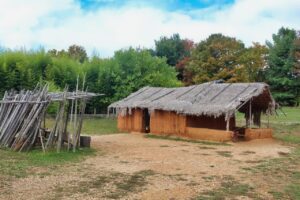
1. West Africa Exhibit 1700
Our walk back in time starts with the West Africa Exhibit in the Old World area of the Frontier Culture Museum. Old World Exhibits are focused on the daily lives of farming households in Europe and West Africa.
These African huts are accurate reproductions of those found in 18-century Igboland, in what is now known as Nigeria. Igbo life was focused on agriculture, community, and ancestor worship.
The transatlantic slave trade was at its peak during this time. An estimated 30,000 Igbo were taken from their homeland and sent to the state of Virginia between 1716 and 1755.
As with all of the Virginia history museum’s exhibits, an actor demonstrated household chores and answered questions.
This exhibit made a powerful impression on us as we learned about the daily lives of the African people who were brought to America against their will.
READ MORE: The 10 Best Restaurants in Staunton VA to Visit

2. England Farmhouse 1650
Our next stop in the Old World was at a Worcestershire, England farm house circa the mid-17th Century.
Built by an independent farmer and nestled by a small lake, this timber-frame home is one of the prettiest buildings at one of the best museums in Virginia.
Heather and I both love old architecture, and this charming house was a beautiful example of the impact British design and innovation had on American homes.
One highlight of our visit to the England Farmhouse was the actor, a young lady in a beautiful authentic period dress.
She walked us through the home while sharing the trials and pleasures of life in merry old England in 1650.
READ MORE: Where are the Blue Ridge Mountains? A State-by-State Guide

3. Irish Forge 1750
A dependable blacksmith was an essential part of any 18th century village.
Skilled blacksmiths were responsible for creating, mending, and improving the tools and equipment necessary for the daily work of farmers and villagers, both in the Old World and the New.
This 1750s-era Irish forge came from County Fermanagh, in what is now Northern Ireland.
We were fortunate to catch a live demonstration of a blacksmith hard at work in this authentic forge, a small dark building illuminated by a blazing fire. Although the Fall day was a bit chilly, the forge felt like an oven!
Of all the live demonstrations saw at the Staunton VA museum, this one was the most visually impressive, showing the hard work and ingenuity of the early settlers.
READ MORE: Exploring the Crooked Road, Virginia’s Appalachian Music Trail
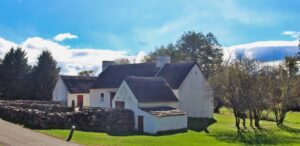
4. Irish Farm 1750
Our path continued to an Irish Farm from County Tyrone, in what is now Northern Ireland.
This farm is like many that were left behind by the Scots-Irish immigrants, who came to the New World for the promise of a better life.
We spent most of our time exploring the gardens and outbuildings of this rustic, yet beautiful homestead. Heather was enchanted by a trio of white cats frolicking around the property.
The interior of the house was cramped, but cozy, with a prominent fireplace for cooking and heat. We watched a young costumed actor as she knitted by the crackling fire, recounting tales from 1750s life and culture.
In the early days, the Staunton VA area had so many Irish settlers, it was often referred to as “the Irish Tract.”
READ MORE: 30 Fun Facts About Appalachian Scots-Irish History & Culture

5. German Farm 1750
The German farm at the Frontier Museum is a masterful example of timber-framed buildings from the Rhineland Palatinate in southwest Germany.
Complete with a house, barn, and outbuildings, this traditional peasant homestead gives visitors a chance to immerse themselves in 18th century rural Germany.
Taxation, famines, and a shortage of farmland made survival difficult for peasant farmers in the southwestern territories of Germany in the 1700s.
By 1775, approximately 100,000 German-speaking immigrants had come to the American colonies, and most were tenant farmers and rural artisans.
The skill and determination of these early farm families is evident throughout the farmhouse and barn. We loved the antique furniture, quilts, and hand-made children’s dolls and toys.
READ MORE: The 10 Best Things to Do in Harrisonburg VA & Rockingham County

6. American Indians 1700
After the German exhibit, we left the Old World and entered the America Exhibits. The first exhibit is a reproduction of an Eastern Woodlands Indian community located in the Great Appalachian Valley in the 1700s.
This small encampment reflects the Native American culture before English settlers arrived. The hut had an open fire, handmade clay cooking pots, and tightly woven baskets typical of American Indian life.
As the ill-equipped settlers moved into the area, these indigenous people helped them adapt to their new homes by using traditional American Indian knowledge to survive.
This enabled the colonists to expand farther into the wild frontier, ultimately taking over American Indian lands.
The contrast between the native lodges and the European-style cabins was a striking reminder of the impact these settlers had on the New World.
READ MORE: The 10 Best Restaurants in Harrisonburg VA to Visit
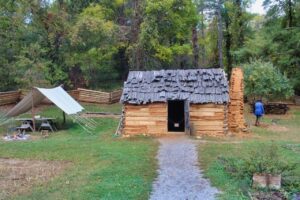
7. Valley of Virginia 1760
This primitive log cabin is an example of a single-room home typical of the early Scots-Irish settlers in the Virginia Mountains.
These tiny starter homes could easily be abandoned if the settler was unsuccessful, or if successful settlers wanted to build larger homes.
A living history interpreter was busy making clay for cabin repairs when we arrived at the exhibit. He shared the struggles of life on the frontier and the daily routine of a settler.
We took some time learning about 1760 Virginia, and I even had a chance to try digging with an old shovel. Clearly I needed more practice!
Having to duck my head to take a quick look around the interior of the log cabin was a reminder of how modern life is so far removed from the lives of our Blue Ridge Mountains forefathers.
READ MORE: The 15 Best Things to Do in Lexington VA & Natural Bridge VA
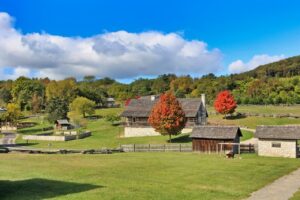
8. Valley of Virginia 1820
The museum‘s landscape and buildings changed dramatically as we travelled from 1760 to 1820. Leaving the little log cabin behind, we were greeted by grand multi-room homes with numerous outbuildings.
This 1820s Virginia farm was built by a German immigrant in Rockingham County, close to where we live in Harrisonburg VA.
Farmers in the Shenandoah Valley were mostly focused on grains and livestock. During our visit to the Staunton Frontier Culture Museum we saw Devon cows, sheep, chickens, and one extremely large pig!
Because of the home’s larger size, we spent more time viewing the details inside, which included antique furnishings, kitchen wares, and tools required to manage an early 1800s farm.
The Valley of Virginia exhibit is a great place to stop for a picnic, with picnic tables and benches available for use.
READ MORE: The Best Restaurants in Lexington VA & Natural Bridge VA for Foodies
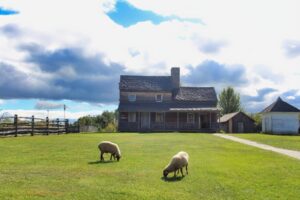
9. The Valley of Virginia 1850
The last farmhouse we visited at the Staunton museum is also the largest in the Valley of Virginia exhibits.
As we walked towards the front door, we were greeted by woolly sheep eating grass in the front yard. Out back, the garden was filled with enough produce to sustain a family of hard-working farmers.
Farms this size would be expected to produce enough crops and livestock to sustain itself, while also creating some surplus for trade or sale.
Inside, this farmhouse had an open floor plan, with all bedrooms on the second level. Beds were covered in bright Appalachian quilts, while a plain side room had a simple bedding area for a farm worker or enslaved person.
A living history actor in a handcrafted wooden rocking chair knitted in front of a massive fireplace, entertaining patrons with her stories and anecdotes of 19th century life in the Shenandoah Valley.
READ MORE: The 10 Best Things to Do in Bristol TN/VA
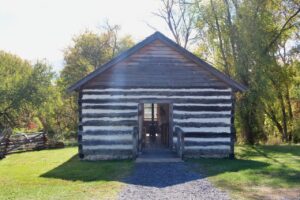
10. African American Church 1860
This old log building is the last exhibit on tours of the Frontier Culture Museum in Staunton VA, and it’s always one of our favorites.
It’s perched atop a hill in the American Exhibits section, so we enjoyed the views of the Blue Ridge Mountains of Virginia and the serenity of the sanctuary.
Historical records show that this building housed the Mount Tabor United Methodist Church of New Hope, Virginia. According to oral tradition, the church was constructed by enslaved African-Americans around 1850.
African-American families are also said to have used the log building as a school during the post-Civil War period of Jim Crow segregation.
Religion served as a source of comfort and relief for many African-Americans, both during and after the abolishment of slavery in America.
As we stood in the sanctuary, we could easily imagine the sound of harmonious voices raised in song. It was a fitting end to our journey through our favorite Staunton VA museum. –text & photos by Heather Taylor & Jon Weaver

